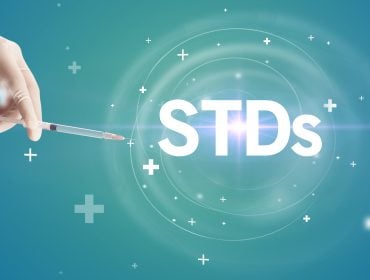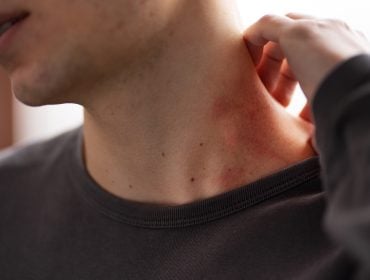Which STDs Cause a Rash?
You might wonder which STDs can lead to a skin rash. Well, certain ones like syphilis and HIV are known for this symptom. With syphilis, you may notice worsening of an existing rash after treatment begins, a reaction called Jarisch-Herxheimer.
As for HIV, rashes vary based on your immune health measured by CD4 cell counts; the lower it dips below 500 cells/μL, the more likely rashes from conditions such as herpes or fungal infections can appear. Gonorrhea also causes rashes but less commonly and typically away from the face and scalp areas.
Understanding STD-Related Skin Rashes
Certain STDs might lead to skin rashes, and it’s key to know them. Syphilis can cause various signs including chancres; these are often seen with secondary symptoms like rash. In more severe cases related to weak immunity, an ulcerative form known as lues maligna may arise.
Treating syphilis early is critical since penicillin-related Jarisch-Herxheimer reactions could worsen existing rashes. With HIV, the health of one’s immune system plays a big role. A higher CD4 count means milder issues like fungal infections or dermatitis whereas lower counts bring serious conditions such as Kaposi sarcoma and other viral complexities involving herpes viruses or CMV.
Understanding which STD causes each type of rash improves diagnosis and treatment. Recognizing syphilis symptoms and the link between CD4 levels and skin issues in HIV patients aids in effective care management.
Common STDs and Associated Rash Symptoms
You may not see them, but some STDs cause rashes that tell a different story. If you spot odd signs on your skin, it might be linked to an infection down below. Chlamydia can show up as mucus or pus-like discharge from private areas.
But syphilis steals the spotlight with painless sores in round silence, they’re sneaky like that, then hits with red-brown rashes anywhere or velvety marks where hands and feet touch ground most. Remember these tales of hidden traces next time your body speaks in unusual ways, it could mean much more beneath those silent symptoms. Always check back with docs when doubts creep in about strange new spots, they’ll map out answers clearer than any rash ever will.
Identifying Syphilis Through Its Signature Rash
A small sore, or chancre, shows up first where the bacteria got in, maybe hidden inside you and tough to see. This sore is painless but it’s serious; it sticks around for 3-6 weeks then heals without help. Now watch out: as that clears up or even earlier, another sign can pop up, a faint rash. It often begins on your body’s middle parts like chest or back and can spread to arms and legs too, even palms and feet aren’t safe!
Without quick treatment from your doctor with penicillin, this bug can hurt vital organs over time. If pregnant get tested right away because babies need protection too. Remember symptoms might fade, but the danger stays unless treated early!
HIV’s Telltale Skin Manifestations
HIV can mess with your skin in many ways. It weakens the body’s guard against illness, which means you might get skin issues more often. These could be fungal, viral, or even cancerous spots that show up when the immune system is down.
People living with HIV, a whopping 69% of them, often see these troubles on their skin. Medicine for HIV can also lead to rashes; some drugs do this more than others. The rash may cover just a little part or much more space on your body’s surface – it depends.
Now remember: not all who have such marks carry HIV within them. But if you’re worried about strange changes on your skin and what they mean, talking to a doc always helps clear things up. For those deep into fighting AIDS or just wanting knowledge bombs dropped—there are hubs packed with info out there ready for use!
Discovering a rash can be alarming, especially when it might signal an STD. Common culprits often include herpes, syphilis, and HIV—each causing distinct skin changes worth noting. Herpes presents with painful sores; syphilis starts with firm round ulcers; late stage HIV may result in eczema-like rashes.
For peace of mind and health’s sake, don’t ignore these signs. Seek prompt testing through StdCheck to stay safe or catch issues early, a clear path to treatment and control lies ahead for those who take action swiftly.
Medically Reviewed by Joshua Hwang, MD on March 27, 2024
Secure and Confidential
STD testing services
The fastest results possbile - available in 1 to 2 days

Tagged
Categorized As
Author: STD Check Editorial Team
At STDCheck.com, we go to great lengths to ensure quality content. We’re using our own collection of data. It is not bought or made up for “click-bait” purposes. We don’t entice traffic with cheesy graphics or raunchy headlines. Our information is to promote STD testing, educate people, let go of social stigmas, and bring awareness. We also provide a completely confidential atmosphere through private testing. When we produce an article, it is fact-based. We check it with medical advisors that approve it. Our staff consists of doctors and other medical professionals who peer review the content we make available on STDCheck.com. From all over the world, we have sourced the best and the brightest content developers, including medical professionals, marketing engineers, data scientists, content specialists, and media relations.




